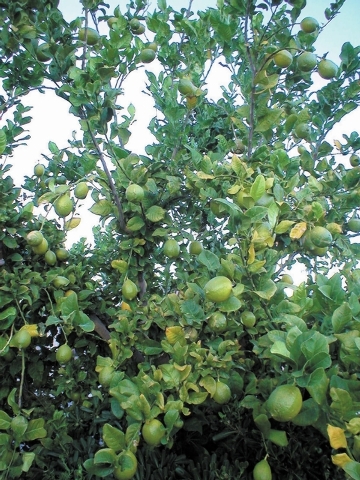Taste best way to tell if lemon is ripe

Q. How do I determine the best time to pick lemons? Mine are yellow with some being very firm and others feeling “givey.” This has been a good year and my Meyer lemon “bush” will afford us lemon curd and juice for the next year.
A. I would pick them as they mature, which usually will be late November through possibly the early part of January. You should have them all picked, however, no later than mid-January, so you do not interfere with next season’s production.
They will keep very nicely for a few weeks in the fridge. I would pick which is the yellowest and taste it. As it gets colder, more flavors will develop. Pay close attention to how it tastes now and pick one in a week or so and compare as the season progresses.
Another option is to use a device that measures the sugar content of the fruit. One such device is called a refractometer. Refractometers measure the sugar content of liquid from inside the fruit by passing sunlight through it and detecting how this light is altered.
They can range in price from about $50 to $200 depending on how sophisticated you want it. You can find them online from companies that sell equipment to orchards.
I am guessing you will hit the peak about early to mid-December. But still the best way to judge is by taste.
Q. I have a 25-year-old Chinaberry tree that I like because it has aromatic flowers in the spring, but I also hate it because it is messy. Parts of the tree were recently broken by the wind. There were still lots of leaves on the tree, but the inside was dry and dead. How long do these trees live and is what I described normal?
A. Chinaberry is also called Persian lilac and in the United States we sometimes call it the Texas umbrella tree. I like the tree because of its form, fragrant flowering and fruit clusters but many local horticulturists do not.
The leaves and fruit can be poisonous to humans but not to birds. It is native to parts of Asia where the leaves and fruit have been used as a natural repellent of pests in dried food. The poisonous chemicals inside leaves and fruit are closely related to the natural pesticide, neem. The tree is a fairly close relative of the neem tree as well.
Just like you said, it can be messy and the wood is brittle and can break easily in the wind. For these reasons, they do not last long in landscapes.
The inside of any older tree is all dead wood. It is just the outside cylinder that is alive. Insects that tunnel or build homes in dead wood can cause damage to the tree if they get inside. Wood rotting fungi however is seldom a problem in this tree since the wood naturally resists decay. It is also a relative of teak and the wood is actually attractive.
Boring insects feed on the living parts of the tree, not the dead parts. However insects such as termites and carpenter bees can use the dead wood inside the tree if they can somehow get inside. If they do get in, they can weaken the tree further increasing the chances it will fail in strong winds.
I have never seen boring insects in this tree but I have seen carpenter bee damage to the interior dead wood when the tree is damaged. If you look closely at the interior of the tree I suspect you’ll find large holes in the inner dead wood about the size of a nickel and perfectly round. This is a good sign carpenter bees were actively nesting inside, further weakening it.
You are probably better off replacing the tree with something else.
Q. I have a Mexican fan palm in my backyard in Mesquite that was planted from a 24-inch box nearly five years ago in December. Last year the top fronds began curving down leaving the new, emerging central fronds sticking up. When they emerged, they were a uniform bright yellow color while the others remained green. When summer came it returned to a normal color. Now, it is doing the same thing again this year.
A. That sort of yellowing in fronds from the central bud can be a sign the central bud is extremely weak or dying. If the bud of a single trunk palm dies, the palm dies. Sometimes a fungicide drench to the bud in early spring may help prevent this.
On another note, palm trees should never be planted during late fall or the winter months. They usually have a harder time getting established if planted during that time of the year. The best time to plant them is in the spring or summer months.
Another possible problem could be nutritional. I would apply some iron chelate around the base of the tree in early spring and water it in. Apply a landscape fertilizer along with an iron chelate containing EDDHA as the chelate in the ingredients.
Another possible problem might be keeping the soil too wet or the soil might not be draining water very well. Soils that hold too much water can cause this type of yellowing as well. Make sure the soil drains easily. If the palm is in a low spot in the yard you might have to move it where water does not accumulate.
Q. My Japanese privet was doing great. I gave it your EDDHA iron chelate elixir six months ago. I was watering three times a week and have cut back to once a week. The leaves are yellowing with brown spots, the same as it did last year. So, what should I do to get the green back?
A. We see this yellowing of the leaves quite a bit in Ligustrum or privet. They prefer moist and enriched soils so I think this is a combination of both a lack of fertilizer and poor soil conditions.
They are not a good plant for desert landscapes and rock mulch. The yellowing is most likely a combination of high light intensity and a general decline in health. Poor health makes them more reactive to tough conditions.
I would get a decent fertilizer such as Miracle Gro or Peters and spray it on the foliage along with a teaspoon of Ivory liquid in each gallon of water. I would follow up with some compost applied at the base of the plants and wood mulch covering it to a depth of 4 inches.
You will see a reaction to this “elixir” next spring, not now.
Keep the soil around the plant moist and don’t let it dry out or privet will drop its leaves. The mulch will help to enrich the soil over time and keep the soil moist.
Make sure it is getting watered often enough. Three times a week with surface mulch should work well. Ten to 15 gallons of applied water should be enough for this plant as a shrub.
This plant prefers to be treated more like a rose than a cactus.
Bob Morris is a horticulture expert living in Las Vegas and professor emeritus for the University of Nevada. Visit his blog at xtremehorticulture.blogspot.com.


















